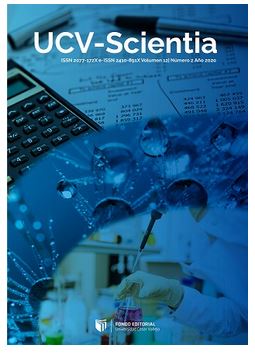Effect of vaginal re-colonization by potential probiotic Lactobacillus sp. in women with bacterial vaginosis
DOI:
https://doi.org/10.18050/revucv-scientia.v3i1.895Keywords:
Bacterial vaginosis, Vaginal probiotic, Probiotic LactobacillusAbstract
One strain of Lactobacillus, identified as Lactobacillus sp. BMP9, was selected from among 320 strains isolated from vaginal swabs of between 8 healthy women with Nugent's score 0. Lactobacillus sp. BMP9 was chosen on the basis of its peroxide of hydrogen production mainly (25 mg/L), incubated at 37°C for 48 hours in Man Rogosa Sharpe broth, determined by Peroxidos-Merkoquant® enzymatic test.It was showed the antagonistic activity of Lactobacillus sp. BMP9 strain against Staphylococcus aureus through the spoton-lawn method of Lewus and in the supernatant of lactobacillary culture by the growing inhibition zone and the optic density no change of strain indicator, respectively.The effect of vaginal re-colonization by Lactobacillus sp. BMP9, at bedtime for 7 nights, in women diagnosed with bacterial vaginosis (BV) by Nugent test showed cure of 81,75% (13/16) of BV and in the normal women (Nugent: 3 points) it wasn't observe negative effects of 100% (4/4) follow-up at day 30 post-treatment control (p<0,05) and Odds ratio 1,44. Lactobacillus sp. BMP9 strain could be a good alternative probiotic to the treatments and prophylaxis of BV and others genital infections to research.
Downloads
Downloads
Published
How to Cite
Issue
Section
License
Copyright (c) 2011 UCV - Scientia

This work is licensed under a Creative Commons Attribution-NonCommercial 4.0 International License.
- Share — copy and redistribute the material in any medium or format
- Adapt — remix, transform, and build upon the material.
- The licensor cannot revoke these freedoms as long as you follow the license terms.
Under the following terms:
-
Attribution — You must give appropriate credit, provide a link to the license, and indicate if changes were made. You may do so in any reasonable manner, but not in any way that suggests the licensor endorses you or your use.
-
NonCommercial — You may not use the material for commercial purposes.
- No additional restrictions — You may not apply legal terms or technological measures that legally restrict others from doing anything the license permits.














